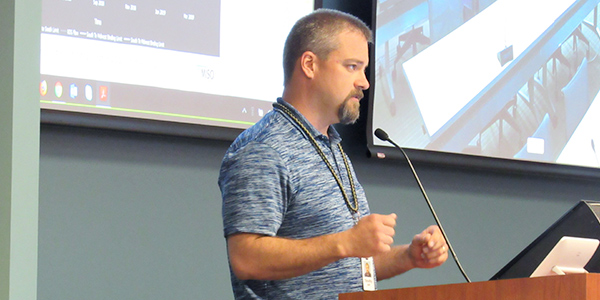By Amanda Durish Cook
CARMEL, Ind. — MISO says a new process to better contain flows on its North-South settlement transmission path is working as intended.
The new practice was prompted by a MISO South maximum generation event in January 2018, where the RTO exceeded the limit on the transmission linking its Midwest and South regions over multiple dispatch intervals. (See Louisiana Regulators Question MISO South Max Gen Event.)
MISO staff spent several months reassessing the RTO’s control of transfer flows after the violation, Director of System Operations Tim Aliff said during a Market Subcommittee meeting Thursday.
Now, MISO has switched from using its Unit Dispatch Systems (UDS) to “real-time and raw measurements” to reduce instances where the limits are exceeded, Aliff said. As of August 2018, the RTO also reduced the effective transfer limit in its system to 90% of contractual values.
Aliff said the two dispatch methods — using UDS and real-time operator monitoring — can result in different megawatt predictions on the settlement path.
MISO said its strategy so far “has resulted in greatly reducing number and duration of exceedances.” Aliff said using a 90% threshold of the settlement limit dramatically cuts — but doesn’t eliminate — limit overruns. From January to August 2018, MISO exceeded transfer limits on 2,073 occasions. Since August 2018, MISO has exceeded the limits 522 times.
Customized Energy Solutions’ Ted Kuhn said the changes make MISO “a good citizen.”
WPPI Energy economist Valy Goepfrich asked whether the RTO intentionally violated settlement limits using the UDS in January 2018 to dispatch the North in order to serve the South.
“We didn’t plan to exceed the limits,” Aliff answered, saying a variety of factors, including a dearth of generation in MISO South, caused the RTO’s raw flows to exceed the settlement limits.
During the past winter, Independent Market Monitor David Patton observed that the settlement path bound frequently in the south-to-north transfer direction because of cold weather in the northern part of the footprint. He said MISO had been derating regional transfers from what was originally scheduled so it didn’t exceed the megawatt limits laid out in its settlement agreement with SPP. Patton said such derates caused the contract path to bind almost 300 MW below the megawatt limit on average this winter.
“I think it’s worth in the future thinking about how to calibrate these scheduling limits so we’re making full use of the” regional directional transfer, Patton said at an April 11 Market Subcommittee meeting, adding that both the South and Midwest regions benefit in different seasons with full use of the megawatt limit.
While MISO came close to violating the 2,500-MW limit on the south-to-north constraint during the Jan. 30-31 maximum generation emergency, it did not ultimately exceed the limit. The settlement agreement stipulates that MISO has an obligation to reduce internal transfers within 30 minutes once the limit is exceeded. The two RTOs also agreed that transfer limits can be temporarily increased or decreased to avoid a system emergency, provided there is adequate communication and the actions don’t cause an emergency in a neighboring balancing authority. MISO and SPP maintain a six-member operating committee composed of their staffs and joint party representatives to oversee compliance with the settlement agreement.
MISO is also currently accepting proposals for projects designed to relieve the North-South transmission constraint, predicting the settlement path flows will become increasingly expensive. (See MISO Seeking Proposals to Relieve North-South Constraint.)
The RTO said it will continue to monitor and calibrate flow control to determine whether additional changes are needed.





